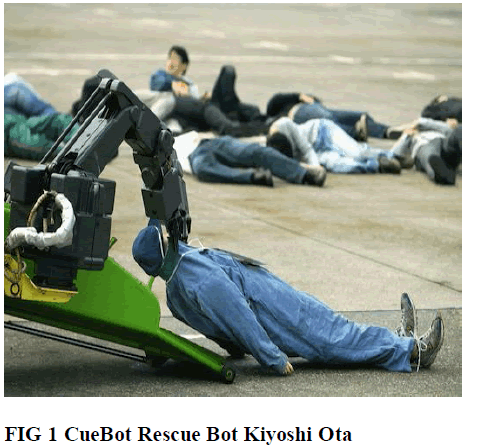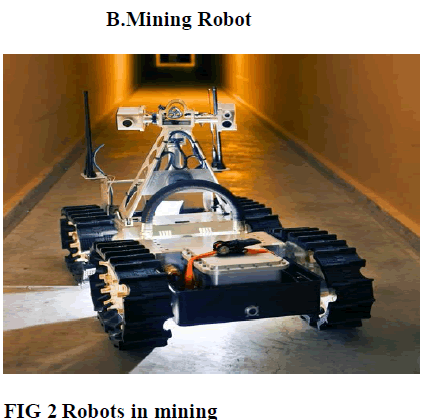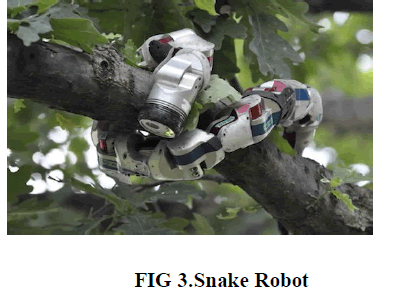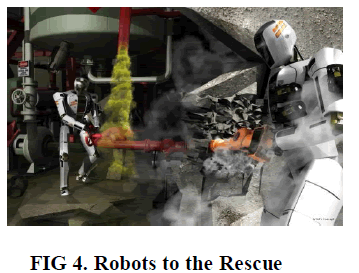ISSN ONLINE(2278-8875) PRINT (2320-3765)
ISSN ONLINE(2278-8875) PRINT (2320-3765)
| Surbhi, Swathi Priya, Sowandarya UG Students, Department of ECE , Aarupadai Veedu Institute of Technology, Payanoor, Chennai, India |
| Related article at Pubmed, Scholar Google |
Visit for more related articles at International Journal of Advanced Research in Electrical, Electronics and Instrumentation Engineering
Rescue robots are one of these things, containing a computer that reacts with the robots hardware to become a life-saving tool. The possibilities are high and the limitations are few. With the help of rescue robots, looking over recently used robots, the purpose of them helping us to save life and do general rescue work has gone mostly as wanted and with accomplished results. Still, like always, there are things to improve. This paper gives an overview of the development of where rescue robotics stands today and what might be the future for them. It will also give a briefly introduction to the concept of rescue robotics and what is important to think about when working with it. To be able to manage all possible obstacles and be dynamic we have to know in which environmental conditions the robots have to manage.
INTRODUCTION |
| Saving victims of natural and human made disaster demands sophisticated and organized rescue planning from a government [6]. The aim is to get out to the disaster areas, find the victims and help them as fast as possible. Disasters come with many obstacles for the rescue team that makes it hard for them to reach the victims, for example rainstorms, collapsed buildings, obstructions and dangerous substances. The rescue team must fast and securely find information of the disaster areas, a task that is both hard and dangerous Rescue robots, that is a type of field robots, can serve as appreciated tools for human teams under disasters [12]. They can reach places between rubble and hazardous places that humans can not, and effectively gather crucial information. The robots can also reach victims through narrow spaces and apply them with fluids and medication. To be useful tools the rescue robots must be smart and dynamic so they do not become obstacles for the rescue team. Because of the unstructured and dynamic environment that occurs during disasters, the robots are nowadays in a degree teleoperated, which demands that the robots have a good communication with the rescue team. |
DIFFERENT TYPES OF RESCUE ROBOTS |
| There are mainly four types of rescue robots that can be categorized like this: |
UGVs |
| Unmanned Ground Vehicles. These robots works on the ground and can help rescuers to find and interact with trapped or hurt victims, in areas were human cannot enter. |
UAVs |
| Unmanned Aerial Vehicles. These robots can easily transport medical treatments to victims and can give the responders a bird view of the situation. |
UUVs |
| Unmanned Underwater Vehicles. These robots can search trough water and find victims, dangerous subject or substance. Cannot use GPS signals yet. |
USVs |
| Unmanned Surface Vehicles. These robots work on the water surface, and can help rescuers to locate and bring the right equipment to the victims. |
| The rescue robots can further be divided in three groups, depending on the model size. When choosing the size its important to know what the robot should be capable of and how soon after a disaster it might be used. The sizes are: Manpackable, Man-portable and Maxi-sized. |
| Man-packable is typically small and they can easily be carried to the disasters hot zone immediately Man-portable is little bigger in size and may need two person, or a vehicle to be carried. These robots often need to wait before the path is curved up |
| Maxi-sized robots are the biggest type and they need trailers for transportation, and they can be used in the hot zone and directly on the rubble. |
HOW RESCUE ROBOTS ARE USED IN NATURAL DISASTERS |
| Natural disaster involves earthquakes, tsunamis, hurricanes, typhoons, volcanoes, avalanches, landslides and floods. Natural disasters usually affecting a radius of 200 km or more . |
| Because it affects huge buildings and infrastructures, the searching part has to cover all possible places victims could be found. It is important to design robots for this type of task because a natural disaster usually affects a large number of survivors. Uninjured survivor can survive up to around 72 hours, which is called the golden 72 hours. Usually rescue teams are divided into small teams to search trough the area. In applying rescue robotics in these types of situations the problem is to find and reach the victims, because of the environmental condition that are often water related. To get an overall picture of the situation of searching trough the area, UAVs are favored to use, mainly smaller ones of type man-portable and manpackable. They can be directly launched from anywhere. To reach the victims with possible medical treatment and help, USVs are considered to be a favor to use rather than UUVs and UGVs. Combination of UAVS and USVs are more commonly used |
HOW RESCUE ROBOTS ARE USED IN MANMADE DISASTERS |
| Compared to natural disasters, manmade disasters occur in a smaller area. Examples like terrorist bombing, serious accident, leak of dangerous substance, radioactive leak and so on. The area afflicted in the danger zone exist within 10 km .The challenge here is not to look at the entire external extent of the damage, but rather to see the interior of the rubble, location and condition of the survivors and state any potentially danger. Visibility is difficult due to no lighting and gray dust. Recognize the victims, potential danger and accurate mapping is more important here. The survivors in the hot zone are often in directly need of medical treatment or evacuation within 48 hours. Therefore the challenge is to be able to search through all possible obstacles found in the building collapses and reaches the victims as fast as possible. UGVs are recommended for this type of disasters, and it is strongly suggested that the UGVs should be waterproofed or highly water resistant, because there are usually some water present that comes from damaged sprinkler and sewage systems. These robots should be man-packable, as small as possible for driving through the rubble. Rescuers can supposedly interact with the victims when found, so there is no need for larger size robots in human-robot interaction. |
RESCUE ROBOTS USED IN DISASTERS |
A. Japan's Earthquake Search-and-Rescue Robots |
| The combination of vulnerability to earthquakes and a natural affinity for robotics has led to a surplus of Japanese rescue robots. Though the earthquake that struck Japan's eastern coast earlier today has left the country with massive destruction and hundreds of deaths, modern technology (and Japan's impressive level of readiness) are helping the country track survivors and dampen the damage as much as possible. |
| In the future, our ability to cope with natural disasters will only increase, due in large part to the particular talent earthquake-vulnerable areas--especially Japan (and to a lesser extent, California)--have for robotics. Predicting earthquakes is still a remarkably fruitless effort-- seismologists are not reliably able to predict even a particular month in which an earthquake will occur, let alone a day. So the work done to mitigate the damage done by earthquakes is often in post-quake search-and-rescue tactics. |
 |
| Interestingly, two of the most earthquake-prone places in the world are also two of the world's hotbeds of robotics engineering. Japan is situated along the so-called Pacific Rim of Fire, at the point where the Pacific and Eurasian tectonic plates collide. The country is continually at risk of massive earthquakes, and as a technological world power, is uniquely capable of creating technological salves for 'quakes. |
 |
| At AUVSI's (Association for Unmanned Vehicle Systems International) massive robot conference in D.C. this week there is no shortage of robots designed to seek out--and in some cases destroy--human targets. Sandia National Labs chose to go in the opposite direction with their Gemini-Scout, a remotely controlled rolling robot designed specifically to lead search and rescue efforts in the event of a mining disaster. |
C.Robot Snake |
| Carnegie Mellon's modular snake robot has been tested for use in both rescue operations and situations where neckshaped objects need a good stranglin'. Now it has a new trick: slithering through collapsed buildings to find trapped people. Here, the snake robot is going through a trial run at "Disaster City," a rescue testing ground run by the Texas A&M Engineering Extension Service. |
| Like the last rescue video we saw, the 'bot is deployed from the back of a rescue dog, then slithers around on its own, sending live video back to its drivers. This pancaked building seems like the ideal space for the compact, flexible machine: it maneuvers the cramped spaces expertly. |
 |
D.Humanoid Robots |
| A humanoid robot is a robot with its body shape built to resemble that of the human body. A humanoid design might be for functional purposes, such as interacting with human tools and environments, for experimental purposes, such as the study of bipedal locomotion, or for other purposes. In general, humanoid robots have a torso, a head, two arms, and two legs, though some forms of humanoid robots may model only part of the body, for example, from the waist up. Some humanoid robots may also have heads designed to replicate human facial features such as eyes and mouths. Androids are humanoid robots built to aesthetically resemble humans. This disaster scene is part of DARPA's new Robotics Challenge. The robot on the left is fixing a leaky pipe, and the robot on the right is breaking through a wall using a power tool. |
 |
| The challenge consists of several difficult tasks. The robot must: |
| Drive an ATV or other similar utility vehicle, operating all the controls, ignition, steering and brakes. |
| Walk across uneven, debris-strewn terrain. |
| Clear a rock or cinder block from a doorway, turn a handle and open a door. |
| Climb a ladder and move across a catwalk (potentially one of the trickiest tasks, because a human would have to use arms and legs to do this). |
| Break open a concrete wall, like the drilling robot is doing in the image above. |
| Find and fix a leaking pipe, as the other robot is doing in the picture. |
| Remove and replace a small pump. |
References |
|